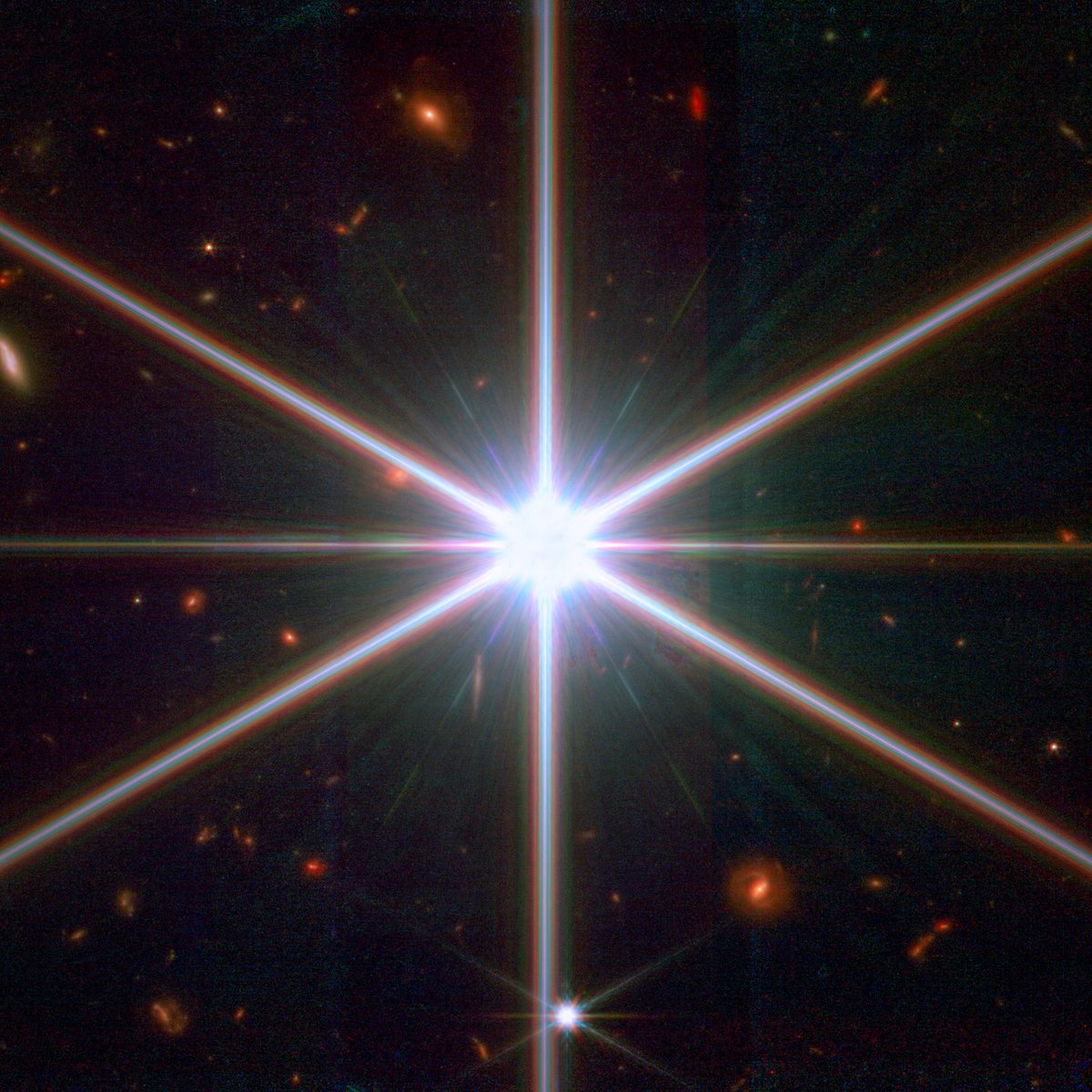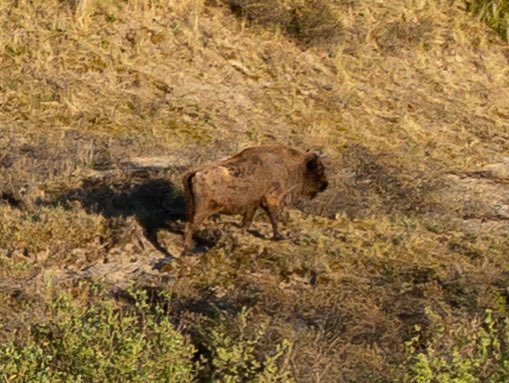
Wave-particle duality.
#JWST senses light from distant stars & galaxies as photons, their energy liberating electrons in the detectors.
But the light also has wave-like properties, interacting with the geometry of the telescope optics to create diffraction patterns.
#JWST senses light from distant stars & galaxies as photons, their energy liberating electrons in the detectors.
But the light also has wave-like properties, interacting with the geometry of the telescope optics to create diffraction patterns.

This is a full-resolution blow-up of the star 2MASS J17554042+6551277, used for focus measurements in March 2022. Data processing by @gbrammer & @CosmicSprngJWST, with some enhancement by me in LightRoom.
https://twitter.com/CosmicSprngJWST/status/1560732171249373185
@gbrammer @CosmicSprngJWST Dan Coe at @stsci made this colour combination using #JWST images in several different wavelengths from 0.7 to 4.4 microns, combined with his publicly-available Trilogy code.
https://twitter.com/DanCoe2/status/1561304980740521984
@gbrammer @CosmicSprngJWST @stsci The image illustrates the "point spread function" or PSF of #JWST, i.e. how the light from an unresolved point source is focussed & diffracted by the various parts of the telescope & instrument optics.
@gbrammer @CosmicSprngJWST @stsci The PSF of #JWST is dominated by its primary mirror, which focusses the core of the light from a distant object into a very sharp image. #JWST does this almost perfectly, i.e. delivering the maximum theoretical resolution or "sharpness" for a 6.5 metre diameter telescope.
@gbrammer @CosmicSprngJWST @stsci That "diffraction-limited" resolution is linearly dependent on wavelength, so that the "sharpness" of the images is twice as good at 2 microns wavelength as at 4 microns. #JWST matches that theoretical prediction at all wavelengths above ~1 micron, better than required.
@gbrammer @CosmicSprngJWST @stsci In addition to the central very sharp core, burned out in this image due to the brightness of the star, the most obvious features are the six spikes separated by 60º.
These are due to the diffraction of light by the edges of the hexagonal primary mirror segments.
These are due to the diffraction of light by the edges of the hexagonal primary mirror segments.
@gbrammer @CosmicSprngJWST @stsci You can see those edges & overall geometry nicely in this image of the #JWST "pupil", essentially the primary mirror.
This image comes from a larger one posted by @SpaceGeck here:
This image comes from a larger one posted by @SpaceGeck here:
https://twitter.com/SpaceGeck/status/1560363038556839936?s=20&t=b_QqqLvMAfeg-XaaArobzg

@gbrammer @CosmicSprngJWST @stsci @SpaceGeck You can also see the three struts of the secondary mirror support structure in the pupil, which unfolded when #JWST was deployed after launch. These hold the secondary mirror out in front of the primary mirror, sending the light back through the central hole in the primary. 

@gbrammer @CosmicSprngJWST @stsci @SpaceGeck The lower two struts are at the same angle as some of the hexagonal edges of the primary segments, so don't add additional diffraction spikes.
But the upper vertical one does, leading to the fainter horizontal bar / spikes in the PSF image, between the six main ones.
But the upper vertical one does, leading to the fainter horizontal bar / spikes in the PSF image, between the six main ones.
@gbrammer @CosmicSprngJWST @stsci @SpaceGeck You can also see some smaller features & "glare", which are due to very small residual wavefront errors in the overall optics of #JWST.
These are not a problem at all for 99.9% of science & are only visible when images of bright stars are enhanced, as I've done here.
These are not a problem at all for 99.9% of science & are only visible when images of bright stars are enhanced, as I've done here.

@gbrammer @CosmicSprngJWST @stsci @SpaceGeck Interestingly, when discussing this image with @marshallperrin & @leefeinberg1 yesterday, we saw the much fainter spikes at ±30º. We weren't quite sure where in the overall telescope-instrument train they come from, but their origin will no doubt be tracked down.
@gbrammer @CosmicSprngJWST @stsci @SpaceGeck @marshallperrin @leefeinberg1 As I said earlier in this thread, the "sharpness" of #JWST's PSF is wavelength dependent & so is the structure of the various diffraction spikes.
If you take a narrow band filter, admitting a limited range of wavelengths, you see quite a lot of structure in the spikes.
If you take a narrow band filter, admitting a limited range of wavelengths, you see quite a lot of structure in the spikes.
@gbrammer @CosmicSprngJWST @stsci @SpaceGeck @marshallperrin @leefeinberg1 When you use a wider filter, admitting more wavelengths, those features appear at slightly different positions for each wavelength in the band, essentially washing them out a bit.
@gbrammer @CosmicSprngJWST @stsci @SpaceGeck @marshallperrin @leefeinberg1 And when you superimpose images taken in several different filters / wavelength bands, you get some interesting colour effects, as the diffraction spikes sizes & structures at different wavelengths combine, as seen in this blow-up. 

@gbrammer @CosmicSprngJWST @stsci @SpaceGeck @marshallperrin @leefeinberg1 People often ask why the JWST PSF is different to the Hubble Space Telescope one, which has more "classical" cross-shaped diffraction spikes, as seen in this image from an article about telescope diffraction by @StartsWithABang.
forbes.com/sites/startswi…
forbes.com/sites/startswi…

@gbrammer @CosmicSprngJWST @stsci @SpaceGeck @marshallperrin @leefeinberg1 @StartsWithABang The reason is simply that Hubble has a round primary mirror & its secondary is held in place by a cross-shaped spider. There are also three circles in its pupil due to the mounting points holding the Hubble primary mirror in place. 

@gbrammer @CosmicSprngJWST @stsci @SpaceGeck @marshallperrin @leefeinberg1 @StartsWithABang Another question is whether we'll be able to remove these diffraction spikes from #JWST images.
In principle, yes.
If you rotate the telescope to a different angle when observing the sky, the spikes will appear to rotate relative to objects on the sky.
In principle, yes.
If you rotate the telescope to a different angle when observing the sky, the spikes will appear to rotate relative to objects on the sky.
@gbrammer @CosmicSprngJWST @stsci @SpaceGeck @marshallperrin @leefeinberg1 @StartsWithABang If you take enough of images at different rotation angles, then you could stack them up & remove the spikes with an algorithm such as median filtering. Even a pair of images rotated by 30º would help, as the spikes from one image would lie in the gaps between them in the other.
@gbrammer @CosmicSprngJWST @stsci @SpaceGeck @marshallperrin @leefeinberg1 @StartsWithABang In practice, however, it'll depend very much on your science goals & the targets you're looking at.
In some parts of the sky, such as the ecliptic poles, #JWST can observe for much of the year & you'll get a rotation of pointing angles naturally.
In some parts of the sky, such as the ecliptic poles, #JWST can observe for much of the year & you'll get a rotation of pointing angles naturally.
@gbrammer @CosmicSprngJWST @stsci @SpaceGeck @marshallperrin @leefeinberg1 @StartsWithABang In others, like the ecliptic, #JWST can only look at targets for very short windows during the year & at a restricted set of angles due to the orientation constraints on the telescope (that'll need another long thread to explain 🙂)
@gbrammer @CosmicSprngJWST @stsci @SpaceGeck @marshallperrin @leefeinberg1 @StartsWithABang And because NIRCam has 2 modules separated by a gap, each with 4 detectors in the short-wavelength channel separated by smaller gaps, making fully-filled mosaics is tricky. If you do so at multiple rotation angles, the overlapping field will become smaller, reducing efficiency. 

@gbrammer @CosmicSprngJWST @stsci @SpaceGeck @marshallperrin @leefeinberg1 @StartsWithABang So, practically speaking, you're going to see diffraction spikes a lot in #JWST data: they're a direct consequence of wanting / needing a very big, very cold telescope located at L2 & we all knew that from Day One. And for a great majority of the science, they're not an issue.
@gbrammer @CosmicSprngJWST @stsci @SpaceGeck @marshallperrin @leefeinberg1 @StartsWithABang Conversely, for some science, looking for very faint things near to very bright things, e.g. planets orbiting around distant stars, we have other clever ways of suppressing the diffraction spikes, albeit often at some cost to efficiency & sensitivity.
jwst-docs.stsci.edu/jwst-near-infr…
jwst-docs.stsci.edu/jwst-near-infr…

@gbrammer @CosmicSprngJWST @stsci @SpaceGeck @marshallperrin @leefeinberg1 @StartsWithABang These kinds of "coronographic mask" techniques will be used in different forms & ways by NIRCam, MIRI, & NIRISS on #JWST to provide much more contrast near bright stars, but that'll need a whole other thread to go into.
@gbrammer @CosmicSprngJWST @stsci @SpaceGeck @marshallperrin @leefeinberg1 @StartsWithABang But for now, let's end it here with the wider-field mosaic around 2MASS J17554042+6551277, albeit at much-reduced resolution for Twitter: you can view & download the full-res version from by @gbrammer & @CosmicSprngJWST / Dan Coe here:
easyzoom.com/imageaccess/98…
easyzoom.com/imageaccess/98…

@gbrammer @CosmicSprngJWST @stsci @SpaceGeck @marshallperrin @leefeinberg1 @StartsWithABang The more you learn about the engineering marvel that is #JWST, hopefully the better you appreciate how its various "features", including the diffraction spikes, are the result of its scientific aim to help us better understand the Universe we were made from & are part of.
/end
/end
• • •
Missing some Tweet in this thread? You can try to
force a refresh














